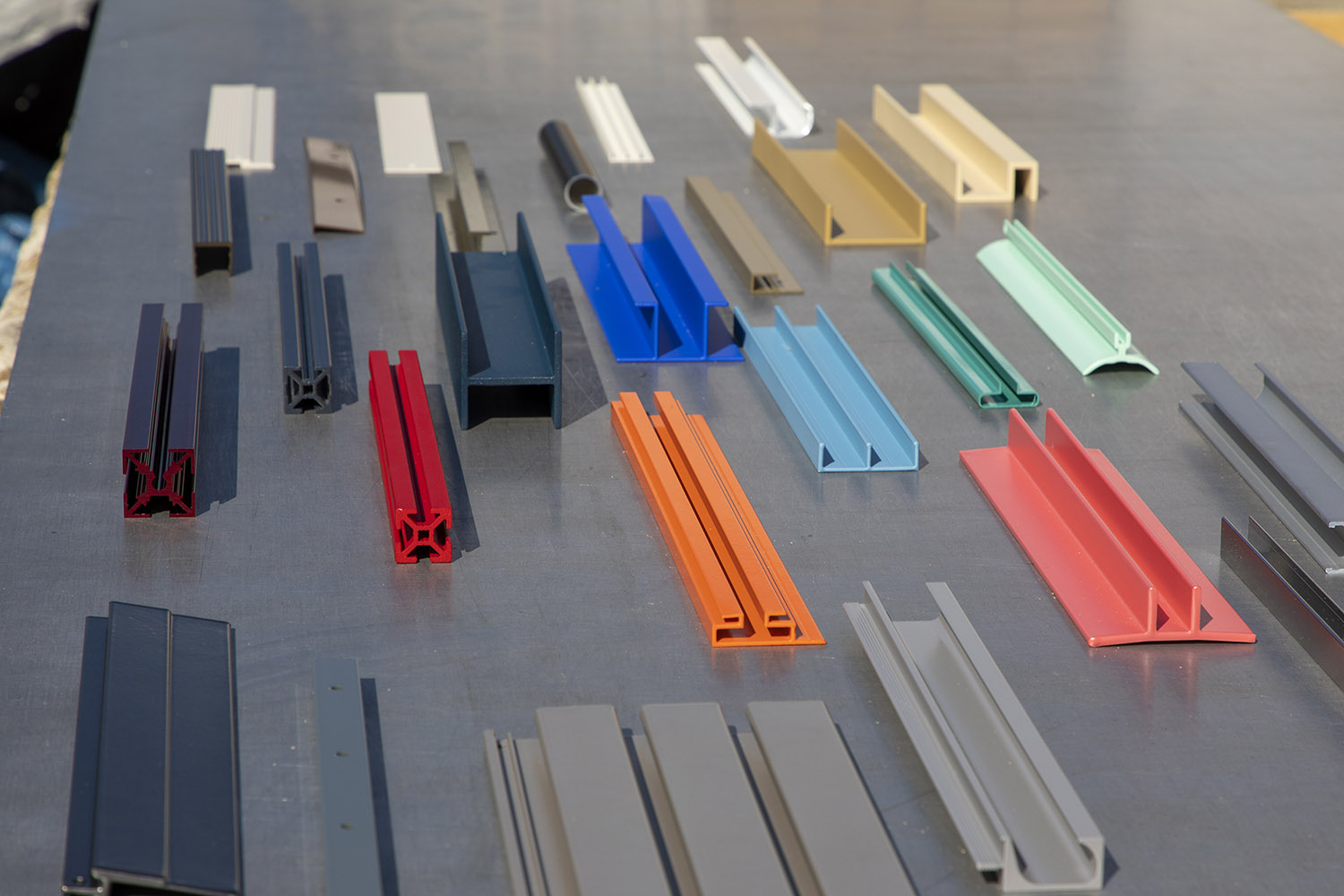Aluminum Extrusion Glossary: Terms and Definitions

Aluminum extrusion is a complex process—but, like any specialized operation, not everyone is familiar with the vernacular used to discuss the products, materials and techniques used.
This guide is here to help.
In the following sections, we’ll define extruded aluminum and 31 other common terms you’ll hear in the industry.
What is Extruded Aluminum?
Extruded aluminum is heated, pressurized, shaped and treated to produce long pieces of material for structural or decorative purposes. To demystify this somewhat-vague definition, imagine a PlayDoh press.
By fitting the PlayDoh press with a specific die shape and forcing the dough through the die, you can make long sections of dough in a uniform shape. Sections can be flat, hollow, solid, curved or take just about any shape you can imagine.
The aluminum extrusion process is the same, except that:
- Aluminum alloys (or “billet”) are heated before extrusion
- Extrusion machines use high-powered hydraulic presses
- Extruded aluminum can be cut, treated and aged
Glossary of Terms
Now that we’ve defined aluminum extrusion, let’s explore some more industry lingo.
A B C D E F G H I J K L M N O P Q R S T U V W X Y Z
A
- Aluminum/Aluminium – Aluminum—called aluminium in the late 19th and early 20th centuries—is the most abundant mineral found in the earth’s crust. However, it’s rarely found in its pure form in nature, so it must be refined before use (in most cases).
- Aluminum Alloy – An aluminum alloy is a metal containing aluminum and one or more other metals. To be considered an alloy, pure aluminum may not comprise more than 99.0% of the metal.
- Annealing – Like many other metals, aluminum becomes harder to work with the more it is manipulated and shaped—a phenomenon known as work hardening. Annealing—a heat treatment process—reverses the effects of work hardening, making aluminum softer and more workable. Annealing temperatures range from 570°F to 770°F.
- Anodizing – Anodized metal features a protective, functional or decorative top layer produced by electrolytic oxidation—using electricity and submersion in ionically charged liquids, manufacturers create this top, oxide layer. Oxide layers can be clear or colored.
B
- Billet/Extrusion Billet – Billet—or extrusion billet—is an ingot cut to a specific shape or length before it’s heated for extrusion. Both billet and ingots are cast, alloyed metals that have already been prepared for hot or cold metalworking.
C
- Chemical Brightening – Chemical brightening makes extruded products more reflective. Commonly used in jewelry applications, brightening solutions contain a variety of ingredients including distilled water, potassium cyanide or oxygen peroxide.
- Chemical Polishing – Instead of (or in addition to) using mechanical polishing with solid media (like sandpaper), manufacturers can polish aluminum by submerging aluminum products in a liquid solution. Chemical polishing can improve reflectivity, remove minor blemishes or both. Aluminum is typically chemically polished with Sulfuric acid, orthophosphoric acid or nitric acid.
- Clear Anodized Aluminum – Manufacturers produce clear anodized aluminum for an unfinished look with a decreased risk of corrosion. Via electrolytic or chemical oxidation, a colorless oxide layer forms on top of the aluminum alloy, improving durability and appearance without changing the color of the metal.
D
- Die – The die is a critical piece of the aluminum extrusion process—the metal mold that heated aluminum is pressurized through to produce a specific shape. In everyday life, you encounter dies when you pipe frosting through a shaped metal tip or force toothpaste through an opening in the tube. Both the frosting tip and the hole are dies that determine the shape of the extruded product.
E
- Extruded Length – An extruded length is a piece of extruded metal that has been cut to a specific size. Extruded lengths are often cut using saws before they’re aged, treated or processed.
- Extruded Profile – An extruded profile is a small section of extruded metal. They typically showcase the exterior shape of the die, and they’re usually not hollow. They can be used for decorative purposes or prevent waste if materials are miscut.
- Extruded Shape – An extruded shape and an extruded profile are interchangeable terms—both are any extruded piece of metal that doesn’t form a standard bar, rod or wire.
- Extrusion – Extrusion, in the most general terms, is the process of pressurizing a material (or billet) through an opening in a die. We encounter extrusion every day—when we squeeze a tube of toothpaste, pump lotion out of a bottle or press sealant out of a container using a caulk gun.
- Extrusion Ingot – Before it becomes billet (which will be heated and pressurized to create an extruded product), aluminum must first become an extrusion ingot—the alloyed metal product that will be cut to size before extrusion. Manufacturers will produce extrusion ingots with specific metal components and chemical properties based upon the extruded product’s intended application.
F
- Fatigue Strength – Fatigue strength is an expression of the stress that a material can sustain before it has a 50% or more probability of cracking, warping or degrading. Manufacturers and engineers test fatigue strength in controlled lab settings to ensure appropriate material applications.
H
- Homogenizing – To prevent micro-segregation (molecules of the same metal grouping together in an alloy, which can reduce the alloy’s strength or appearance), manufacturers homogenize metals by heating them to just below solidus temperature (the lowest possible temperature a solid can reach before changing to the liquid phase).
M
- Machinability – Machinability describes how easily a machine or other piece of automated equipment can produce a suitable surface finish on a solid product. If a metal is easily finished using mechanical means, it’s considered machinable.
- Matte-Finish – A matte-finish is a diffused, low-shine finish often produced by etching, blast cleaning, rolling or brushing after extrusion. A gloss-finish, alternatively, would feature a higher shine than a matte-finish.
- Mill-Finish – Extruded products that aren’t finished (via brushing, rolling, anodizing, polishing or other means) after extrusion and cutting, feature a mill-finish. While mill-finished metals can meet aesthetic requirements, they’re not always appropriate for all applications. Clients that seek a mill-finish aesthetic with higher functional qualities may consider a clear anodized finish instead.
P
- Plastic Deformation – Plastic deformation describes a permanent change to a product under any kind of stress—extreme temperatures, pressures or torque, for example. Some plastic deformations include cracks, stretching, dents, bends or buckling.
- Powder Coating – Powder coating, introduced in the US in the 1960s, is a dry finishing process for metals. Numerous different formula types exist for powder coating, each with distinct purposes. These formulas are typically mixed, cooled and ground into powder. The powder is applied to a metal piece with a spray gun, and some powder coatings must be cured in high heat.
S
- Snap-Fit Joint – Snap-fit joints are an economical and simple option for jointing one or more parts together. Instead of using screws or bolts to attach a locking mechanism to secure two pieces together, snap-fit joints are built-in protrusions and depressions in each component, allowing for easy, aesthetically pleasing closure.
- Strain-Hardened Aluminum (H Temper) – Strain-hardened aluminum, or H Temper aluminum, has been heavily worked to harden and strengthen the metal. But H temper aluminum can only be minimally heat-treated (if at all), so manufacturers sometimes use cold metalworking techniques for tempering.
- Sublimation – When a solid substance sublimates, it skips the liquid phase and immediately turns into a gas. Metalworkers can use sublimation to infuse ink into metal via heat transfer. After printing their desired pattern, text or color onto transfer paper, they press the paper to metal under high temperatures, where the ink turns into a gas and binds to the metal.
- Surface/Mechanical Finish – After extrusion, manufacturers have a variety of options for finishing the surface of an extruded piece. Some surface and mechanical finishes include polishing, grinding, brushing and embossing.
T
- Temper – Temper describes specific conditions of metal that directly result from mechanical or thermal processing. For instance, H Temper (or strain-hardened) metals have been heavily worked to increase the strength of the material.
- Tensile Strength – Sometimes called “ultimate tensile strength,” tensile strength describes the maximum stress a piece of extruded metal can withstand before experiencing plastic deformation. Tensile strength is tested in controlled lab conditions and helps manufacturers choose the appropriate materials for specific applications.
- Thermally Treated Aluminum (T Temper) – T Temper is the most common temper for heat-treated alloys. T Tempered aluminum has been heat-treated in a chemical solution, quenched and aged in a furnace or at room temperature.
- Tolerance – Tolerance describes the maximum accepted deviation from a specific parameter or characteristic. Tolerance is often described in ranges but varies per parameter. Tolerances help maintain quality control in metalworking and other industries.
W
- Wrought Alloy – Wrought alloys are specially formulated for hot- or cold-worked wrought products. Wrought metals are typically mechanically worked on an anvil, while cast metals are formed in a mold or through a die.
Y
- Yield Strength – Sometimes called “proof strength,” yield strength is a numerical value that describes the stress needed to produce a specific kind of plastic deformation on a specific final product. Yield strengths are tested to help manufacturers choose appropriate products and to bolster quality control efforts.
Orange Aluminum: Your Source for Extruded Aluminum
Aluminum extrusion is a wide-ranging process—manufacturers have countless alloys and treatment processes to choose from and can transform billet into just about any shape or size you can imagine.
But the process can be complex, and an expert aluminum extrusion partner can help you navigate your options to choose the perfect material for your project. Here at Orange Aluminum, we’ve been manufacturing extruded aluminum products since 2007, creating products for architectural applications, structural purposes and everything in between.
As a national leader in aluminum trim, shapes and bars, we’re committed to high-quality processes and innovations that continue to advance the field of aluminum extrusion. When you’re ready to start your next project, contact us—we can’t wait to make your vision a reality.
Sources:
Aluminum Extruders Council. Aluminum Extrusion Process Basics. https://www.aec.org/page/aluminum-extrusion-process-basics
Global Advisory Group. Terms and Definitions. https://www.aluminum.org/sites/default/files/2021-09/GAG_001_Terms_and_Definitions_3rd_Edition_2011_01_August_21_2011_JW.pdf
Royal Society of Chemistry. Aluminum. https://www.rsc.org/periodic-table/element/13/aluminium
Balestri Technologies. Chemical Brightening Machine. https://www.youtube.com/watch?v=dAfbfjHNqo4
ScienceDirect. Chemical Polishing. https://www.sciencedirect.com/topics/engineering/chemical-polishing
Science Direct. Plastic Deformation. https://www.sciencedirect.com/topics/chemistry/plastic-deformation
Powder Coating Institute. What is Powder Coating? https://www.powdercoating.org/page/WhatIsPC
Bayer Material Science. Snap-Fit Joints for Plastics. http://fab.cba.mit.edu/classes/S62.12/people/vernelle.noel/Plastic_Snap_fit_design.pdf
US Department of the Interior. Sublimation and the Water Cycle. https://www.usgs.gov/special-topics/water-science-school/science/sublimation-and-water-cycle
US National Park Service. Iron Making: Refining into Wrought Iron. https://www.nps.gov/articles/000/iron-making-refining-into-wrought-iron.htm



